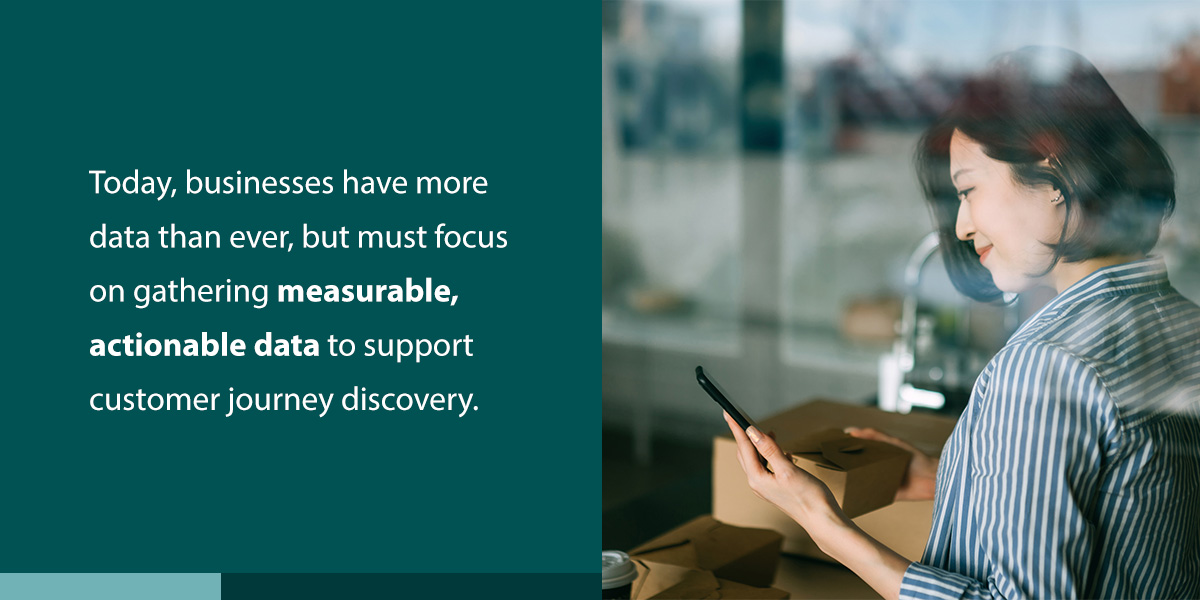Customers are always looking for something more, seeking extraordinary experiences that transform their purchase journeys. Journey analytics is the key way businesses understand the customer experience they deliver, as engaging in journey analytics provides business leaders with a holistic view of the metrics that matter. Businesses can only create better experiences for their customers if they identify journey and experience trends.
There are two main approaches when you explore your customer journey — journey measurement and journey discovery. Together, they are the science of collecting and measuring data, and a vital technique for identifying how customers flow from one experience to the next. You must focus on both approaches to build the best possible experience for your customers. Exploring the customer journey is crucial to business success wherever you start.
Customer Journey Measurement
Customer journey measurement is a process allowing you to measure and improve the customer experience (CX) by measuring metrics that quantify the success of each interaction with your brand. Knowing how to measure the customer journey is vital to overcoming one of the core challenges of journey measurement — data. A lack of data for decision-making was a primary limiter of traditional methods of measuring the customer journey. Today, businesses have more data than ever, but must focus on gathering measurable, actionable data to support customer journey discovery.
Businesses must have a measurement framework to understand the best methods of deriving value from their analysis. It should be holistic and built to help decision-makers understand the customer journey and form a complete picture of your company’s customer experiences.
Customer journey measurement starts with defining journey steps to represent the important transitions in the customer experience. Building these journey steps can refocus decision-makers on key transition points. While these steps are different for every business, they are all built around when customer behaviors and expectations change.
For example, in eCommerce, visiting a website may be a journey step, but every page they visit may not be. Entering a specific search term, adding an item to the cart or completing a purchase may be other examples of journey steps. Your business can focus on measuring the impact of critical transition points once you’ve identified them, which reduces noise in your data so you can limit your scope of examination to the most impactful metrics.
Customer Journey Discovery
A customer journey is the customer’s entire experience with your brand — every interaction from start to end. The process of identifying these journeys is called journey discovery, which is a powerful tool for businesses. It allows you to examine current-state journeys and identify areas for improvement by highlighting where experiences go right or wrong. While this process may seem similar to journey mapping, journey mapping is a strategic, qualitative process. Journey discovery is a quantitative one. They work best hand in hand.
Journey discovery allows you to build better experiences. Take, for example, an airline that uses emails, its website, and a mobile app to communicate with customers. They want to improve the experience for those who have already booked a flight. This airline may have updated its mobile app when there was a gate change and sent an email.
After the journey discovery process, the business may have found that users who saw the gate change on their app had a much lower likelihood of issuing a complaint or rating their experience poorly. The airline might include a link to their app in their emails informing customers of gate changes or delays. But they will only determine whether that has the desired effect by measuring the results.
At your business, the strategies you implement may be very different. No matter what specific strategy you use, you can only take steps to improve by discovering what works — and what doesn’t — on your customer journey.
How to Start Exploring Your Customer Journey
Customer journeys can be varied and complex. Start with a few key journeys in the beginning and build from there. While measuring the customer journey is different for each business, the following steps can help you get started:
- Choose your first journey: Customers will have many journeys with your business, each one starting when they have a new need. Select a priority area that aligns with your business goals and that you can measure to assess your customer journey. In other words, prioritize the metrics that reflect your overall objectives.
- Find the data: Most businesses are overflowing with data from customer interactions. Select the data that gives you the most actionable information on areas you want to improve. For example, to improve complaint resolution, you’ll need data from your website, customer service department and call center to get an accurate view of the customer experience.
- Define milestones: Milestones refer to customers’ steps to reach their goals. Defining your milestones makes tracking progress easy and simplifies measuring your customer journey as a whole.
- Develop scores: The results of measuring the customer journey must be easy to interpret. Talk to an expert about developing journey performance scores using a combination of performance metrics.
Journey Analytics Is the Start, Not the End of Journey Management
When you set out to analyze your customer journey, you are beginning to identify what matters to your customers. Whether you’re starting the journey measurement process or involved in a project that isn’t delivering the expected results, exploring your customer journey will provide clarity and greater certainty.
To see the latest trends in customer journey analytics, check out the recent Spark MATRIX™ report, where CSG secured a Technology Leaders position.
Explore Your Customer Journey With CSG
Exploring and measuring the customer journey can yield valuable insights into how customers feel about interacting with your brand. From there, you must find ways to improve every step of the customer life cycle. Harnessing the power of CSG makes ordinary customer experiences exceptional. We’ll be with you through every step of the customer life cycle, helping you meet customer needs and improving the customer experience on the front and back end.
Contact us to learn more about how we can help you transform the customer journey today!



